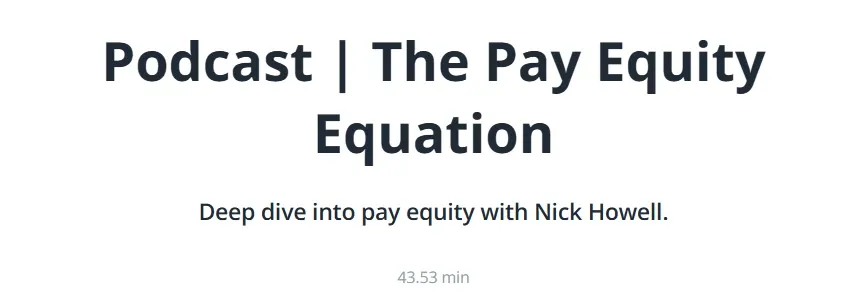
Compensation and benefits are becoming top priorities for organizations looking to stay competitive. A recent Deloitte survey revealed that 56% of organizations have redesigned their compensation strategy in the past three years, and 64% are either retooling or planning to adjust their approach in the next few years. This shift reflects the growing need for companies to adapt their compensation strategies to meet the changing demands of the workforce.
In this blog, we will examine the key compensation trends for 2025, offering insights on how HR professionals can stay ahead of the curve and craft attractive, competitive total rewards strategies.
Compensation refers to the total monetary rewards an employee receives for their work, which typically includes base salary, bonuses, incentives, and other forms of financial remuneration. It is also known as direct compensation. It’s a core component of any employment agreement, designed to attract, motivate, and retain talent.
Benefits, on the other hand, include non-monetary rewards provided to employees in addition to their compensation. These can range from health insurance and retirement plans to paid time off and wellness programs. Benefits or indirect compensation, play a crucial role in employee satisfaction and well-being, enhancing the overall employee experience.
Together, compensation and benefits from the total rewards package, which is a key factor in attracting and retaining employees. A well-structured compensation and benefits strategy can directly impact employee satisfaction, retention, and overall business performance. Let’s explore why these elements are so important.
Effective compensation and benefits programs reflect the organization’s values, priorities, and commitment to its people. These are a few key reasons why they truly matter:
In a competitive job market, a well-designed compensation package can make your organization stand out and attract highly skilled candidates. For example, generous health insurance or remote work options can be deciding factors for potential employees.
A fair and comprehensive package promotes employee loyalty, reducing turnover rates. It also incentivizes employees to perform at their best, aligning individual goals with organizational objectives.
Competitive pay and meaningful benefits make employees feel valued, which increases their likelihood of staying engaged, productive, and committed to their work.
Organizations with innovative compensation strategies can position themselves as employers of choice. This improves recruitment, retention, public perception, and employer branding.
Having understood the importance of compensation and benefits, let’s take a look at the key trends that will shape these areas in 2025. These compensation trends are driving how companies design competitive pay packages and benefits offerings to meet the growing expectations of today’s workforce.
Suggested Read: How Equity Compensation Works? A Guide for Employees
A tailored approach to compensation and benefits, rooted in both market insights and individual preferences, is important. Success depends on agility, utilizing data for informed decisions, and offering rewards that truly align with the needs of employees.
Here’s a closer look at the top five trends redefining how businesses reward their workforce in 2025.
Advanced tools like AI-driven analytics and automated systems allow HR teams to improve processes, enhance decision-making, and ensure compliance with complex compensation regulations.
Manual compensation processes are prone to errors, inefficiencies, and inconsistencies. Technology simplifies these tasks, enabling organizations to maintain fair pay practices, align with market trends, and respond quickly to employee and organizational needs.
Key technological advancements include:
Employees who understand how their compensation is determined are less likely to feel undervalued, leading to improved morale and productivity. According to a report by Payscale, 59% of employees are less likely to leave their organizations if pay transparency practices are in place.
Transparency and equitable pay are necessary for compliance. It builds trust, reduces turnover, and creates a culture of fairness. Employees who understand how their compensation is determined are less likely to feel undervalued, leading to improved morale and productivity.
These are a few ways organizations are adopting pay transparency:
Pay equity remains a priority for organizations as they strive to close wage gaps and create fair workplaces. Despite progress, disparities persist. For instance, women in the U.S. still earn 82 cents for every dollar earned by men, according to the U.S. Census Bureau. Pay equity is not just a moral imperative but a business necessity.
Steps to ensure pay equity:

Podcast | The Pay Equity Equation
Join Nick Howell, Senior Compensation Analyst at Inspire Brands, for a 43-minute investigation into pay equity. In this episode, Nick discusses the challenges of closing pay gaps and offers practical strategies and actionable plans for achieving pay equity in today’s market.
The one-size-fits-all approach to employee benefits is no longer effective. As workforces become more diverse, organizations must offer flexibility and customization to meet these expectations.
Personalized benefits cater to the unique needs of multigenerational workforces. Younger employees may prioritize student loan assistance, while older employees might focus on retirement planning. Flexibility also supports the evolving demands of remote and hybrid work environments, where traditional benefits may not suffice.
Trends in personalized benefits for 2025 include:
Suggested Read: 15 Great Total Rewards Examples From Companies Worldwide
Monitoring labor costs and carefully planning compensation budgets remain critical priorities for employers. According to the Bureau of Labor Statistics’ Employment Cost Index, total compensation costs for private industry workers increased by 3.9% from June 2023 to June 2024. It decelerated from the 4.5% growth observed the prior year.
Wages and salaries rose by 4.1%, while benefits grew by 3.5% during the same period. Despite these slower rates of growth, compensation budgets are expected to remain sturdy as companies plan for continued uncertainty.
Industry benchmarks provide valuable guidance. World at Work reports that median salary budget increases are anticipated to hold steady at 4.0% for all employees in 2025, with slightly lower increases of 3.8% projected for non-exempt hourly workers and executives. Meanwhile, a survey by The Conference Board indicates a modest rise in 2025 salary budgets, averaging 3.9%.
As compensation and benefits expand to meet workforce expectations, businesses must use automation and data-driven insights to stay competitive. Let’s explore how CompUp’s salary benchmarking solutions simplify decision-making and enhance pay equity.

CompUp is here to help you turn these trends into opportunities. Its innovative approach simplifies complex processes, allowing HR teams to focus on strategic initiatives rather than manual data entry or repetitive tasks. CompUp is a smart, forward-thinking approach to compensation management.
Key features that can help you keep up with compensation trends include:
Whether you are ensuring compliance, maintaining equity, or trying to stay competitive in today’s labor market, CompUp provides the tools and insights you need. With CompUp’s support, you can achieve your goals and lead the way in compensation excellence.
Fair pay practices, transparency, and personalized benefits are critical components of a thriving workplace. By adapting to these trends, companies can build a culture of trust, boost employee morale, and ensure compliance in an ever-changing regulatory environment.
CompUp simplifies pay decisions with Compensation Bands, ensuring fair salary structures. Its Budget Simulation enables strategic resource allocation, optimizing rewards and increments. Meanwhile, the Digital Offer Experience enhances candidate engagement, making compensation more accessible and compelling.
Get all the help you need to stay ahead of compensation and benefit trends in 2025. Schedule a demo and see how CompUp can transform your pay strategies, ensure equity, and simplify compliance.
How are pay transparency laws impacting organizations?
Pay transparency laws require organizations to disclose salary ranges in job postings and to employees. This trend promotes fairness, boosts trust, and ensures compliance with legal standards.
What is the significance of holistic well-being programs in 2025?
Holistic well-being programs address employees' mental, physical, and financial health. These initiatives enhance satisfaction, productivity, and overall engagement while reducing burnout and turnover.
Why are salary increase budgets stabilizing in 2025?
Economic factors and a more balanced approach to compensation planning have stabilized salary increase budgets. The average increase is around 3.9%, slightly lower than in previous years.
How is variable pay being used by organizations?
Variable pay is being used strategically to reward performance without significantly increasing fixed salary costs. Organizations allocate 6-7% of payroll for bonuses and incentives, especially for high-performing roles.
What changes are happening with leave benefits?
Employers are expanding parental leave policies, offering longer maternity and paternity leave, and increasing flexibility through PTO systems, reflecting a stronger focus on work-life balance.
Are these trends relevant for all industries?
While the trends are broadly relevant, their impact and implementation may vary by industry, company size, and workforce demographics. Organizations should customize their strategies accordingly.

Co-founder & CEO, CompUp
Anurag Dixit, founder of CompUp, is a seasoned expert in all things compensation and total rewards. With a deep understanding of the current compensation trends, his vision is to help companies create fair, transparent, and effective compensation strategies.
Revolutionizing Pay Strategies: Don't Miss Our Latest Blogs on Compensation Benchmarking